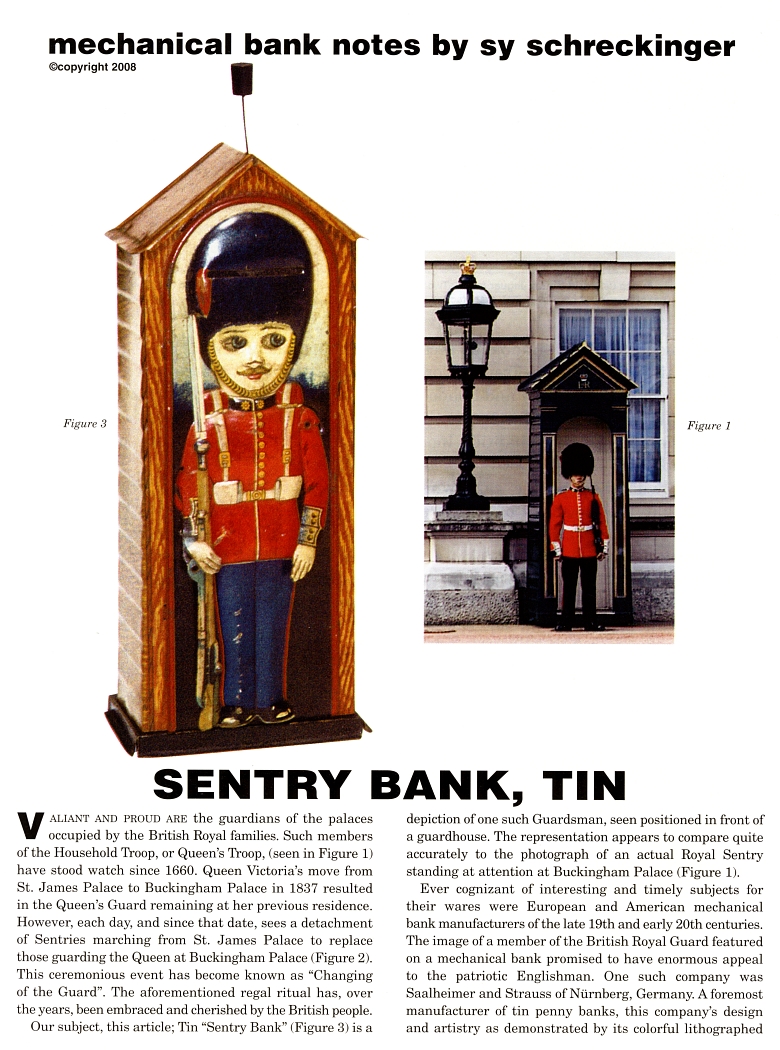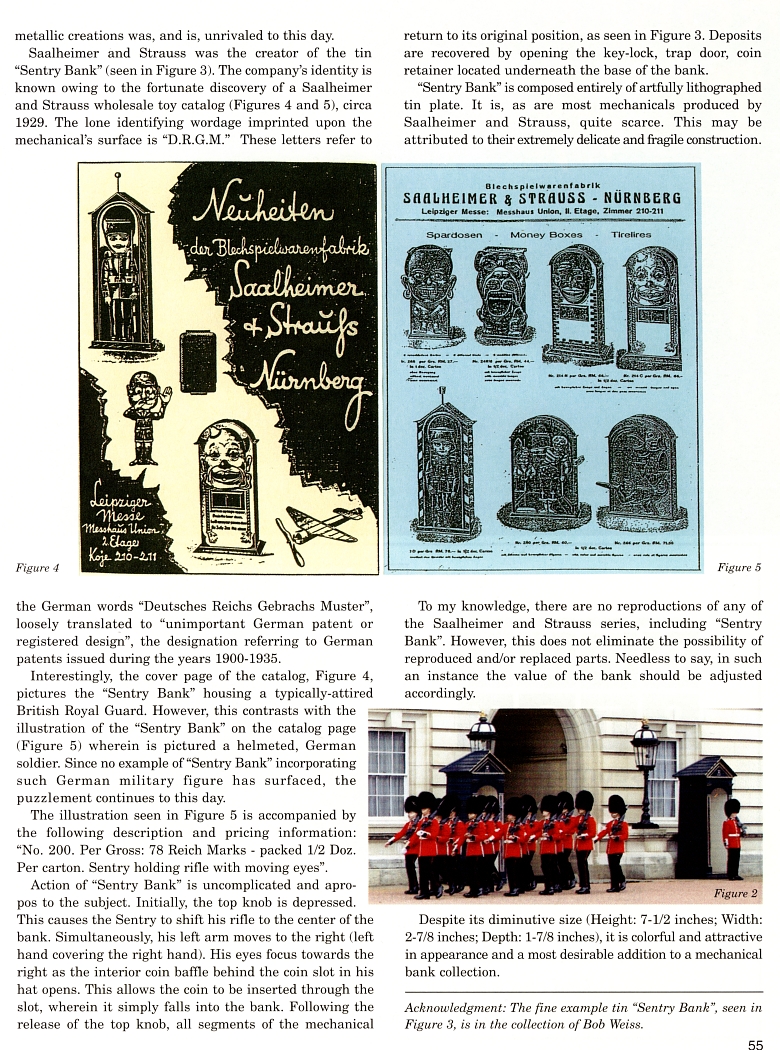|
Sentry Bank, Tin
by Sy Schreckinger – ANTIQUE TOY WORLD Magazine – December, 2008
Vallant and proud are the guardians of the
palaces occupied by the British Royal families. Such members of the
Household Troop, or Queen's Troop, (seen in Figure 1) have stood watch
since 1660. Queen Victoria's move from St. James Palace to Buckingham
Palace in 1837 resulted in the Queen's Guard remaining at her previous
residence. However, each day, and since that date, sees a detachment of
Sentries marching from St. James Palace to replace those guarding the
Queen at Buckingham Palace (Figure 2). This ceremonious event has become
known as "Changing of the Guard". The aforementioned regal ritual has,
over the years, been embraced and cherished by the British people. Our
subject, this article; Tin "Sentry Bank" (Figure 3) is a depiction of one
such Guardsman, seen positioned in front of a guardhouse. The
representation appears to compare quite accurately to the photograph of an
actual Royal Sentry standing at attention at Buckingham Palace (Figure 1).
Ever cognizant of interesting and timely subjects for their wares
were European and American mechanical bank manufacturers of the late 19th
and early 20th centuries. The image of a member of the British Royal Guard
featured on a mechanical bank promised to have enormous appeal to the
patriotic Englishman. One such company was Saalheimer and Strauss of
Nurnberg, Germany. A foremost manufacturer of tin penny banks, this
company's design and artistry as demonstrated by its colorful lithographed
metallic creations was, and is, unrivaled to this day.
Saalheimer and Strauss was the creator of the tin "Sentry Bank" (seen
in Figure 3). The company's identity is known owing to the fortunate
discovery of a Saalheimer and Strauss wholesale toy catalog (Figures 4 and
5), circa 1929. The lone identifying wordage imprinted upon the
mechanical's surface is "D.R.G.M." These letters refer to the German words
"Deutsches Reichs Gebrachs Muster", loosely translated to "unimportant
German patent or registered design", the designation referring to German
patents issued during the years 1900-1935.
Interestingly, the cover page of the catalog, Figure 4, pictures the
"Sentry Bank" housing a typically-attired British Royal Guard. However,
this contrasts with the illustration of the "Sentry Bank" on the catalog
page (Figure 5) wherein is pictured a helmeted, German soldier. Since no
example of "Sentry Bank" incorporating such German military figure has
surfaced, the puzzlement continues to this day.
The illustration seen in Figure 5 is accompanied by the following
description and pricing information: "No. 200. Per Gross: 78 Reich Marks -
packed 1/2 Doz. Per carton. Sentry holding rifle with moving eyes".
Action of "Sentry Bank" is uncomplicated and apropos to the subject.
Initially, the top knob is depressed. This causes the Sentry to shift his
rifle to the center of the bank. Simultaneously, his left arm moves to the
right (left hand covering the right hand). His eyes focus towards the
right as the interior coin baffle behind the coin slot in his hat opens.
This allows the coin to be inserted through the slot, wherein it simply
falls into the bank. Following the release of the top knob, all segments
of the mechanical return to its original position, as seen in Figure 3.
Deposits are recovered by opening the key-lock, trap door, coin retainer
located underneath the base of the bank.
"Sentry Bank" is composed entirely of artfully lithographed tin
plate. It is, as are most mechanicals produced by Saalheimer and Strauss,
quite scarce. This may be attributed to their extremely delicate and
fragile construction.
To my knowledge, there are no reproductions of any of the Saalheimer
and Strauss series, including "Sentry Bank". However, this does not
eliminate the possibility of reproduced and/or replaced parts. Needless to
say, in such an instance the value of the bank should be adjusted
accordingly.
Despite its diminutive size (Height: 7-1/2 inches; Width: 2-7/8
inches; Depth: 1-7/8 inches), it is colorful and attractive in appearance
and a most desirable addition to a mechanical bank collection.
Acknowledgment: The fine example tin "Sentry Bank", seen in Figure 3,
is in the collection of Bob Weiss.
|


